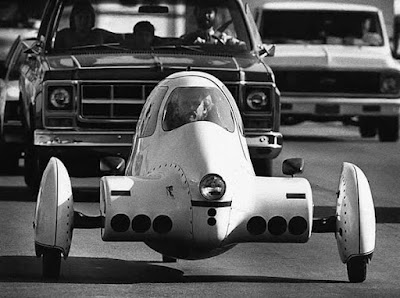Singular Motion - Not too long ago, we explored the curious charm of
the Tracer MK III, a sleek three-wheeled creation that sparked plenty of discussion among enthusiasts of experimental transport. Vehicles like that blur the line between practical transportation and rolling art—and it turns out, there's more where that came from. Meet the
Feora, a one-of-a-kind machine that takes the idea of efficiency, design, and individuality to an entirely new level. Built not by a large company but by the hands of one determined builder, it’s a reminder that innovation often comes from where you least expect it.
 |
| The Ophorst Feora is a hand-built, street-legal three-wheeled vehicle created by Chuck Ophorst in the early 1980s with an aircraft-inspired focus on aerodynamics and efficiency. (Picture from: Back In Time (80s and 90s) in Facebook) |
Crafted by
Charles “Chuck” Ophorst of Bellflower,
California, the
Feora doesn’t fit neatly into any category.
Some call it the world’s most aerodynamic trike,
others see it as a futuristic pod with a Honda heartbeat. Either way, it’s a vehicle that draws eyes—and questions—wherever it goes.
It started with a Honda SL175 Twin-cylinder engine tucked in the rear of a fiberglass-bodied frame,
pushing a streamlined,
tandem-seat capsule that looks like something out of a concept museum. Yet, it’s not just a visual experiment—it moves, and it moves well.
 |
| The Ophorst Feora features a fully enclosed, teardrop-shaped fiberglass body, a tandem two-seat cockpit, and is powered by a compact 175cc Honda twin-cylinder engine mounted at the rear. (Picture from: Ottw.es) |
Despite its light 500-pound frame, the
Feora isn’t just about being nimble. Thanks to its aerodynamic profile and clever engineering,
it can reach up to 85 mph while achieving an astonishing 80 miles per gallon. Those are numbers most economy cars can only dream of, and that’s with
the original 175cc engine.
Ophorst once hinted at installing
a beefier 500cc engine to give it more punch, and the thought alone opens up even more possibilities for this compact machine.
 |
| Charles Ophorst proudly posing with his hand-built Feora trike in 1981, a one-of-a-kind creation that blended aerodynamic design with engineering creativity. (Picture from: Ottw.es) |
What truly sets the
Feora apart is its construction.
The aircraft-inspired space frame made of 1020 drawn steel tubing gives it structural integrity without unnecessary weight.
Front-end rack-and-pinion steering,
triple disc brakes,
and a full set of automotive-style controls inside the capsule show just how much thought and craftsmanship went into the build.
Even airflow was meticulously planned,
with dedicated ducts guiding air from high-pressure zones at the front to keep both engine and passengers cool.
During a test run around town, the
Feora did more than just keep up with traffic—it stopped people in their tracks. From gardeners to shoppers and even fellow motorists, no one could ignore the bright yellow blur as it passed by. That reaction wasn't just because of how unusual it looked, but because it was clearly built with intention and passion. Every weld, every curve, every control—nothing was there by accident.
 |
| The Ophorst Feora has a truly unique look, combining elements of an experimental vehicle, moving art, and ground-bound aircraft, built with a focus on engineering and efficiency over conventional style. (Picture from: Rolling Art in Facebook) |
Though
Ophorst had ambitions of low-volume production and even potential DIY kits, those plans never fully materialized. Rumors of a future four-wheeled evolution floated around, but no concrete versions ever surfaced. Still, even as
a one-off, the
Feora stands as a glowing example of what’s possible when creativity meets craftsmanship.
 |
| The Ophorst Feora features a lightweight fiberglass body with accessible rear-mounted engine placement for easy maintenance. (Picture from: Ottw.es) |
Note: This blog can be accessed via your smart phone.






 It may not be in showrooms or mass-produced, but the Feora captures the spirit of innovation that keeps the world of alternative vehicles alive. Much like the Tracer MK III before it, it's not just about getting from point A to B—it’s about how much imagination you can fit between the wheels. *** [EKA | FROM VARIOUS SOURCES | MAGAZINECYCLEWORLD | OTTW.ES | ROLLING ART IN FACEBOOK | BACK IN TIME (80S AND 90S) IN FACEBOOK ]
It may not be in showrooms or mass-produced, but the Feora captures the spirit of innovation that keeps the world of alternative vehicles alive. Much like the Tracer MK III before it, it's not just about getting from point A to B—it’s about how much imagination you can fit between the wheels. *** [EKA | FROM VARIOUS SOURCES | MAGAZINECYCLEWORLD | OTTW.ES | ROLLING ART IN FACEBOOK | BACK IN TIME (80S AND 90S) IN FACEBOOK ]